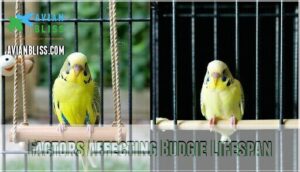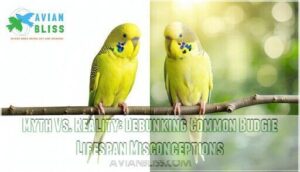This site is supported by our readers. We may earn a commission, at no cost to you, if you purchase through links.

Factors like genetics, diet, and environment play big roles in how long your feathered friend sticks around.
A healthy diet full of seeds, pellets, fruits, and veggies, along with regular vet checkups, can work wonders.
Don’t forget exercise and mental stimulation—budgies love climbing, flying, and playing with toys.
Stress and bad habits like smoking around them can shorten their lives.
A little TLC and a safe, enriching habitat go a long way.
Ever heard of a budgie living to 20? It’s possible!
Table Of Contents
- Key Takeaways
- How Long Do Budgies Live?
- Factors Affecting Budgie Lifespan
- Budgie Lifespan in Captivity Vs. In The Wild
- How to Maximize Your Budgie’s Lifespan
- Coping With The Loss of a Budgie
- What Makes Some Budgies Live Longer Than Others?
- The Average Budgie Life Cycle
- How to Extend The Life of Your Pet Budgie
- Interesting Facts About Budgie Lifespan
- Myth Vs. Reality: Debunking Common Budgie Lifespan Misconceptions
- Frequently Asked Questions (FAQs)
- How long do budgerigars live?
- How to identify if a budgie is less than 18 days old?
- How long do budgies live?
- How old is a budgie if he dies?
- How old is the oldest Budgie?
- What factors affect Budgie lifespan?
- How old do budgies get?
- Can budgies live alone?
- How long do budgies live as a pet?
- How do you know if a budgie is happy?
- Conclusion
Key Takeaways
- Provide a balanced diet with pellets, fresh veggies, fruits, and seeds while avoiding toxic foods to keep your budgie healthy and extend its lifespan.
- Create a safe and clean habitat with proper cage size, air quality, and temperature control to reduce stress and prevent illnesses.
- Regular vet checkups and early illness detection are vital for preventing health issues and ensuring your budgie lives a longer life.
- Keep your budgie active and mentally stimulated with toys, supervised flight time, and social interaction to support its physical and emotional well-being.
How Long Do Budgies Live?
Budgies, commonly known as parakeets, have a lifespan that typically falls between 5 and 15 years in captivity.
With proper care, budgies can thrive and brighten your life for up to 15 years or even longer.
Their average age often depends on key lifespan factors like care, diet, and environment. The common range, known as the budgie lifespan, reflects how well owners meet their needs.
Wild budgies face tough survival challenges, making their longevity shorter—usually 4 to 6 years.
For pet budgies, lifespan determinants include genetics and routine care. Hand-raised budgies or those from reliable breeders may live longer.
However, neglect or improper care can shorten their time with you. While budgie longevity myths suggest minimal effort suffices for their survival, consistent attention to their welfare guarantees your vibrant, feathered companion thrives through the years.
Factors Affecting Budgie Lifespan

Your budgie’s lifespan is influenced by several factors, including genetics, diet, and environment.
Taking proper care of their health and providing a safe, clean habitat can substantially enhance their longevity.
Genetics
Your budgie’s genetics serve as the foundation for its health and lifespan.
Strong genetic diversity often leads to better overall health, while inbreeding increases risks of inherited conditions. Selective breeding for traits like color mutations can sometimes compromise health.
Wild-type longevity reflects nature’s robust selection. Understanding genetics is essential for making informed breeding decisions. Genetic diversity can substantially influence lifespan.
- Key genetic factors:
- Genetic diversity boosts health.
- Inbreeding effects limit lifespan.
- Mutations impact overall well-being.
- Inherited conditions shorten lives.
- Selective breeding influences longevity.
- Wild-Type longevity guarantees resilience.
- DNA testing identifies potential risks.
Illness
Health plays a big role in your parakeet’s lifespan.
Common ailments like respiratory infections, Avian Gastric Yeast, and chlamydiosis can substantially harm budgie health.
Early detection and swift treatment options matter most. Knowing symptoms such as lethargy or changes in appetite helps prevent escalation.
Focus on preventative measures, like regular vet visits, to reduce genetic predispositions and protect against budgie diseases.
Accidents
A safe home keeps your bird healthy and happy.
Accidents, however, can easily shorten a budgie’s lifespan.
Focus on injury prevention with these steps:
- Check for cage hazards like loose wires or sharp edges.
- Supervise open flight to prevent flight accidents.
- Remove toxic exposure, including plants and fumes.
- Block small gaps to stop trapped wings or feet.
- Learn emergency care, so you’re prepared for mishaps.
Nutrition
A balanced parakeet diet is key to vibrant budgie health and a longer lifespan.
Traditional seed mixes may fall short, so opt for pellets to meet supplement needs. Add dietary variety with leafy greens, carrots, and fresh fruits to boost nutrition while avoiding toxic foods like chocolate or avocado.
Rotate foods and observe their behavior for effective foraging enrichment.
- Provide fresh water daily and make certain high-quality, clean seed options are available.
- Gradual dietary changes are better for sensitive birds than abrupt switches.
Environment
A comfortable environment dramatically impacts your budgie’s lifespan.
Set up a safe habitat with excellent air quality, proper temperature control, and adequate cage size to reduce stress and promote health.
Budgies thrive in quiet, spacious surroundings that mimic their natural habitat.
Regularly clean their cage environment, shield them from toxins, and avoid sudden noise.
Here’s a quick guide:
| Factor | Effect |
|---|---|
| Cage Size | Supports exercise and activity |
| Air Quality | Prevents respiratory diseases |
| Temperature Control | Maintains metabolic health |
Budgie Lifespan in Captivity Vs. In The Wild
The lifespan comparison between wild and captive budgies shows how their environments shape their years.
Wild budgies face constant dangers like predators, scarce food, and harsh weather. These Wild Budgie Threats mean they usually live only 4-6 years.
On the other hand, captivity offers advantages like balanced diets, safe housing, and regular care, allowing pet budgies to live 8-12 years, even up to 15 or more in ideal conditions. One key factor in their well-being is ensuring they’ve the right cage size to thrive.
Here’s a clear breakdown:
| Factor | Wild Budgies | Captive Budgies |
|---|---|---|
| Diet | Seasonal, limited | Controlled, balanced |
| Stress | High (predators, weather) | Low (with proper care) |
| Disease Risk | Frequent | Reduced with regular care |
| Physical Activity | Constant (flying) | Variable; exercise essential |
| Environment Safety | Unpredictable | Stable, monitored |
While wild budgie mortality rises through daily survival strategies, the environmental impact of captivity provides safer, longer lives.
How to Maximize Your Budgie’s Lifespan
To help your budgie live a long and healthy life, you need to focus on providing proper care and meeting its essential needs.
A balanced diet, regular vet checkups, and mental stimulation play key roles in keeping your pet thriving for years.
Healthy Diet
What makes a great budgie diet? Start with balanced meals to meet their essential nutrients. Add variety to keep them interested and healthy:
- High-quality pellets provide essential nutrition.
- Offer fresh veggies rich in vitamins daily.
- Always provide clean water to meet their hydration needs.
Consider supplementing their diet with specialized budgie pellets for ideal health.
Avoid toxic foods like chocolate or avocado, and practice portion control to prevent obesity.
Regular Veterinary Checkups
Catch issues early with regular bird vet visits.
Annual routine checkups with an avian veterinarian facilitate early detection of illnesses and provide preventative care, saving time and costs in the long run.
- Schedule yearly veterinary exams to monitor bird health.
- Quarantine any new birds for 30 days to avoid spreading illnesses.
Exercise and Mental Stimulation
Keep your budgie’s mind sharp and body active with mental exercise and physical enrichment. Rotate foraging toys and explore new training techniques like teaching simple tricks.
Social interaction is key, so spend time talking or whistling with them daily.
- Introduce foraging activities to encourage problem-solving.
- Offer supervised flight time to boost physical exercise.
These activities tap into their intelligence, promoting a joyful, enriched life for your feathered friend. If you notice your budgie favoring one side, wing injuries are possible, which can impact their overall well-being.
Coping With The Loss of a Budgie
Losing your budgie is a tough experience, especially after years of bonding. It’s okay to feel sad—grieving is natural.
Grieving a beloved budgie takes time; their memories bring smiles, even as you mourn their tiny, colorful presence.
Acknowledge your emotions and take the time you need to heal. If children are involved, gently explain their feelings are valid and share simple ways to cope.
For support, consider joining online Grief Support groups for pet bird owners who understand. Creating memorial ideas like photo albums, planting a tree, or crafting keepsakes can also bring comfort.
These small gestures honor your bird’s memory while helping you find closure. Reflect on their care to avoid possible end-of-life signs overlooked, like poor diets or toxins.
Learning from these experiences benefits your future bird care. While it’s tempting, don’t rush into getting a new pet. When you’re ready, you’ll know the right time to welcome another companion.
What Makes Some Budgies Live Longer Than Others?
Some budgies live longer because they receive proper care, including a balanced diet, regular veterinary checkups, and a safe environment.
Genetics and disease prevention also play key roles in determining their lifespan.
Health and Disease Prevention
Protecting your budgie’s health starts with preventative care and regular hygiene practices. Monitor for signs of illness like sluggishness or feather loss—early detection saves lives.
Use quarantine protocols for new birds to prevent spreading budgie diseases. Incorporate genetic screening when breeding to reduce inherited issues.
Staying alert to health changes guarantees a longer, happier parakeet lifespan, reinforcing their well-being daily.
Diet
A balanced diet is key to extending your budgie’s lifespan.
Focus on these essentials:
- Pellet Quality: Choose pellets rich in nutrients.
- Fresh Vegetables: Offer leafy greens and carrots.
- Seed Variety: Avoid seed-only diets; mix seeds sparingly.
- Supplement Needs: Provide cuttlefish bone for calcium.
Proper nutrition supports health, from vibrant feathers to active chirps.
Habitat Recommendations
A well-designed budgie habitat boosts their lifespan.
Focus on these essentials:
- Cage Size: Pick a spacious cage with room for flight and movement. A larger cage can provide enhanced budgie comfort.
- Toy Variety: Rotate safe, interactive toys to prevent boredom.
- Safe Materials: Use non-toxic perches and accessories.
- Temperature Control: Maintain a stable, draft-free environment.
- Clean Air & Stress Reduction: Make certain fresh air and a calm, quiet space.
The Average Budgie Life Cycle
A budgie’s life cycle includes key stages, from breeding and hatching to adulthood.
Understanding these stages helps you provide the care your bird needs at each phase of its development, which is a complete concept that requires attention to detail.
Breeding & Nesting
Budgie breeding starts at about one year old, when nesting behavior becomes apparent.
These birds form strong bonds, and males support females during incubation. A clutch size varies from 4-8 eggs.
Chick development depends on parental care and genetic diversity for healthy growth. Nest raiding and egg predation in the wild often affect survival rates.
| Key Fact | Details | Impact on Lifespan |
|---|---|---|
| Breeding Age | Around 1 year | Guarantees maturity |
| Clutch Size | 4-8 eggs | Affects chick survival |
| Nesting Behavior | Strong pair bonds, grooming | Critical for healthy chicks |
Egg
A budgie egg is a tiny marvel, about 1 inch long, with a pristine white shell that guards life within.
The incubation period lasts 18 to 23 days, requiring warmth and care.
Egg fertility often depends on factors like clutch size and health, ensuring eggshell health and nest protection prevents issues like egg predation or nest raiding.
Hatchlings
Hatchlings begin life blind, featherless, and entirely reliant on parental care.
During this critical phase of the budgie life cycle, initial feeding with nutrient-rich "parakeet milk" guarantees proper growth.
Within 10 days, their eyes open, and delicate down feathers emerge.
As pin feathers develop, early socialization and attentive Hatchling Care help lay the foundation for a thriving budgie lifespan ahead.
Adulthood
Adulthood is when your budgie’s personality shines fully, and they reach breeding readiness. Their adult plumage develops, signaling maturity.
Health needs become imperative for prevention of adult health issues and aging signs. Behavior shifts include stronger social bonds and calmer, mature budgie behavior.
One key aspect of budgie health to monitor is potential beak issues.
- Monitor for changes in energy or behavior.
- Provide enrichment to avoid boredom.
- Guarantee a balanced diet and regular vet care.
How to Extend The Life of Your Pet Budgie
If you want your pet budgerigar to stick around for years to come, it’s all about smart bird care and creating the right setup.
A spacious cage is essential—provide perches, room to fly, and an accident-free environment. Engage your bird with bonding activities and safe toys that challenge their mind and keep them active.
To keep them entertained, owners should consider purchasing appropriate toys for budgies.
Help boost your pet bird’s longevity with a balanced diet, including fresh fruits, vegetables, and premium seeds.
Stay proactive by recognizing illness early and scheduling routine check-ups. Being hands-on with first aid can also help in emergencies.
Remember, trust, interaction, and consistent care all play a big role in extending your budgie’s lifespan.
Interesting Facts About Budgie Lifespan
Budgies have some fascinating traits in regards to their lifespan, shaped by their unique biology and environment.
From their sleep patterns to record-breaking ages, these details highlight just how remarkable these small parrots are.
Predators of Budgies
In their natural habitat, budgies face threats from predators like goshawks, falcons, owls, and wedge-tailed eagles.
On the ground, snakes, foxes, and introduced species pose significant risks, especially during nesting.
Predator evasion is critical for survival, with wild predators reducing their lifespan.
Nest predation highlights how vulnerable eggs and chicks are, showing how habitat impact plays a major role in budgie safety.
Oldest Recorded Budgie
The oldest budgie on record, Charlie, amazed everyone by living 29 years, earning a Guinness World Record.
His extraordinary longevity highlights factors like exceptional care, genetic anomaly, and attention to health.
Living this long is rare, but it proves a well-loved bird can defy expectations.
To verify future records, record verification standards guarantee titles reflect true budgie lifespan potential.
Budgie Sleep Patterns
Budgies need 10-12 hours of uninterrupted sleep to stay healthy and maintain high energy levels.
Their sleep environment should be quiet, dark, and safe.
Sleep patterns influence their overall lifespan, keeping them less active at night with quieter behavior during the day.
Chick sleep mirrors adults, showing how essential restful nights are for balancing budgie lifespan and mood.
Myth Vs. Reality: Debunking Common Budgie Lifespan Misconceptions
Misconceptions about budgies’ lifespan can steer owners off course. Let’s clear the air and separate fact from fiction to guide your budgie toward a long, healthy life.
Common myths about budgie lifespan often lead to confusion. Here’s a quick comparison to set things straight:
Myth Reality
Pet budgies can reach a 15-year lifespan with the right care, while wild budgie age maxes out due to natural challenges. Longevity thrives on balanced diets, clean habitats, and mental enrichment, debunking care misconceptions.
Frequently Asked Questions (FAQs)
How long do budgerigars live?
If cared for properly, budgies often live 6 to 12 years, with some reaching Wild budgies face tougher odds, living just 4 to 6 years due to predators and natural challenges.
How to identify if a budgie is less than 18 days old?
A budgie younger than 18 days will be featherless or have sparse down.
Its eyes might still be closed, and it’ll rely entirely on parental care for warmth, feeding, and protection at this developmental stage.
How long do budgies live?
Imagine a tiny bird outliving your pet dog.
With proper care, a budgie can live 5 to 15 years.
Most thrive 8 years, but neglect or poor health might shorten their charming, chirpy lives.
How old is a budgie if he dies?
If a budgie dies, age depends on care quality and genetics. Pet budgies typically live 5-15 years, while wild ones average 4-6 years. Exceptional care extends life, sometimes nearing 20 years.
How old is the oldest Budgie?
The oldest recorded budgie lived to an astounding 29 years and 2 months.
Proper care, nutrition, and a healthy environment played a critical role in reaching this exceptional milestone, far exceeding a typical budgie’s lifespan.
What factors affect Budgie lifespan?
The foundation for a long, healthy life lies in quality care.
Balanced diets, clean environments, exercise, and regular vet visits matter.
Genetics, stress, toxins, and breeding practices also substantially shape a budgie’s lifespan outcomes. The key to a healthy life is found in quality care.
How old do budgies get?
Most budgies typically live 5 to 15 years, depending on their care and genetics. With excellent nutrition and a safe environment, they might even reach 20 years, though that’s rare and exceptional.
Can budgies live alone?
Yes, budgies can live alone, but they thrive with companionship.
Without a buddy, you’ll need to provide plenty of interaction, mental stimulation, and attention to keep your bird happy, healthy, and socially engaged.
How long do budgies live as a pet?
Pet budgies usually live 5 to 15 years, depending on how well you care for them.
A healthy diet, clean habitat, regular vet visits, and mental stimulation can substantially improve their lifespan and well-being.
How do you know if a budgie is happy?
You can tell a budgie is happy when it chirps, sings, or head-bobs energetically.
Fluffing feathers, playing with toys, and eating well are also signs.
A relaxed budgie often perches with one leg up, and these behaviors together indicate the bird’s overall well-being.
Conclusion
While a budgie’s lifespan can vary widely, excellent care makes a big difference.
Good nutrition, a clean and safe environment, regular vet visits, and engaging activities are key to helping your budgie thrive.
Genetics and health play a role, but creating a stress-free, enriching habitat can greatly extend their years.
Whether in the wild or captivity, budgies rely on your attention and love to stay healthy.
With proper care, they may surprise you by living well beyond expectations, and receiving excellent care can make all the difference.
- https://www.guinnessworldrecords.com/world-records/70897-oldest-caged-budgerigar
- https://animaldiversity.org/accounts/Melopsittacus_undulatus/
- https://petdoctorvet.com.au/latest-news/birds-stress-identifying-managing-stress-pet-birds/
- https://www.omlet.co.uk/guide/budgies/biology_and_lifecycle/budgie_lifecycle/
- https://www.talkbudgies.com/threads/english-budgie-lifespan.404628/











